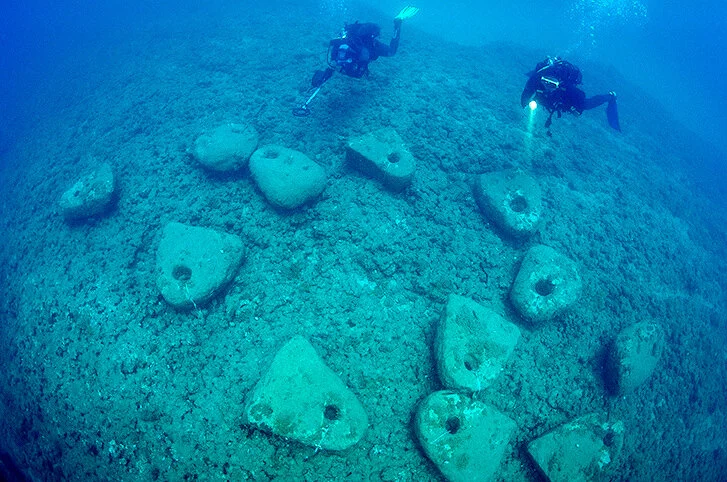Israel’s Marine Archaeology
The Israel Antiquities Authority’s (IAA) Marine Archaeology Unit is responsible for underwater archaeology along Israel’s Mediterranean coast, in the Sea of Galilee, the Red Sea, and also the Dead Sea. The IAA’s marine archaeologists perform hundreds of dives each year, sometimes up to 70 meters deep. Their excavations include shipwrecks, ancient harbors, and submerged prehistoric settlements.
About the Team
The IAA’s Marine Archaeology Unit has 4 staff members directed by Jacob (Koby) Sharvit. Although the team is relatively small, approximately 20 additional IAA archaeologists are trained in marine excavation and assist with large or urgent projects.
The IAA also works with marine biologists from Haifa University and collaborates with institutions around the world including the University of Rhode Island (USA) and the University of Florence (Italy).
Koby Sharvit holding a Roman lamp discovered in a wrecked merchant ship. Photo: Courtesy of the IAA.
“I look at the collaboration as one of the most important things. Sharing data, sharing information, sharing technology...it’s better than working alone.”
Excavating Underwater
According to Sharvit, the basic principal of excavation is the same underwater as on land. “The main difference,” he says, “is the tools we are using.” To name a few, the IAA uses parachutes filled with air to lift heavy artifacts, robotic devices equipped with sonar to survey the seabed, and dredgers to clear away sand while digging. Dredgers work like vacuum cleaners, sucking sand in one end of a tube and depositing it out the other. The IAA also uses metal caissons (like retaining walls) placed in a square around the excavation area to prevent sand from collapsing in as they dig. These are especially useful at prehistoric sites, where archaeologists sometimes need to dig over a meter deep in order to see occupational stratigraphy.
IAA divers using a lifting bag to bring an anchor to the surface. Photo: Courtesy of the IAA.
In the Works
Caesarea Harbor
Caesarea. Photo, Courtesy of the IAA.
In 22 BCE, Herod the Great used hydraulic cement to construct an extensive harbor at Caesarea, making the city a major commercial center in antiquity. Because GPS won’t function underwater, the IAA is using an “Autonomic Surface Vehicle” (ASV) to conduct a detailed survey of the harbor. The ASV communicates with GPS on the waters surface while using a variety of cameras and sensors to map antiquities below.
Atlit Yam
Fresh water well discovered at Atlit Yam. Photo: Courtesy of the IAA.
Atlit Yam is a prehistoric settlement from the Neolithic Period, about 8000-9000 years ago. Researchers estimate the neolithic coastline was about a half-mile out form the modern shore. As a result, Atlit Yam is now about 800 meters offshore and 11meters deep in seawater. The site is extensive, covering about 40 dunams (10 acres). Among other finds, the IAA has discovered houses and a large freshwater well made from stone.
Salvage Expeditions
Fatimid coins discovered off the coast of Caesarea in 2015. Photo: Clara Amit, IAA.
The IAA’s Marine Archaeology Unit is on-call to locate and retrieve discoveries reported by the public. Some of the IAA’s most exciting marine discoveries were first reported by civilians. In 2015, a group of divers from the Caesarea diving club found what they at first thought was a “toy coin.” Their discovery turned out to be a collection of almost 2,600 Fatimid coins from a wrecked ship, and is the largest collection of gold coins ever discovered in Israel.
How You Can Help
The IAA needs your help to provide research and excavation equipment for the Marine Archaeology Unit.
Diving Equipment ($15,000)
Provide eight sets of diving equipment for students and volunteers working with the Marine Archaeology Unit.
3D Modeling Equipment ($15,000)
Help the IAA create 3D models of marine discoveries with equipment that will increase accuracy and save time for divers.
DPV Underwater Scooters - $18,000
Assist the IAA’s divers in covering more area while surveying large antiquities sites.
Close Circular Rebreathers ($25,000)
Enable the IAA’s divers to stay underwater for longer periods of time, especially during deep dives.
Maintain a Research vessel ($25,000)
Keep the IAA’s team safe by replacing generators and equipment in their research vessels.
RemoteLy Operated Vehicle ($60,000 - $80,000)
Help the IAA survey large areas of the sea with a small water robot equipped with sonar, video cameras, and a manipulator arm.












